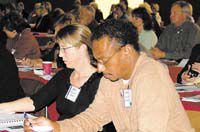| Participants at the Carbon County Events Center take notes about Utah’s changing demographics last Friday. |
Utah is undergoing a radical population change that is directly affecting the state’s labor force, heard a group of about 50 participants during a seminar at the Carbon County Event Center last Friday.
“Utah’s Workforce Challenge: The Changing Demographics How to Avoid a Crisis” drew business owners and staff members of area job training programs interested in learning about the transformation the state is undergoing.
The event deemed a “leader fest seminar” was co-sponsored by the Western Energy Training Center” and according to WETC’s director was pulled together in little more than a month as the urgency of addressing the coming challenges became apparent.
“I just returned from a convention in Seattle and I see that the realities are going to slap us in the face,” said Steve Burge.
What’s slapping the face of leaders in job programs is that Utah is rapidly becoming an older and more diverse state and that the once predominantly white workforce is becoming a thing of the past, according to Pamela Perlich from the University of Utah, who was the keynote speaker at the event.
“The Utah of tomorrow is going to be quite a bit different than the Utah of yesterday,” said Perlich. “This is going to be a permanent change.”
Armed with a plethora of Power Point charts, the senior research economist painted a vivid picture of a state in transition as it becomes one of the key growth regions in the nation. She drove home the decline of the traditional English speaking large, young white family as Utah’s mainstay population.
While Perlich came with about 46 different graphs and charts, in the end, her main points were that Utahns are getting older and older and the state is constantly drawing more and more immigrants.
Two age structure graphs provided a startling comparison of state.
The pyramid in 1870 had a large base of residents under age five and grew increasingly smaller until it reached the very tiny top of those who were age 75 and older.
By 2050 residents in the 75 and older age range are projected to be the majority in the state.
| Dr. Pamela Perlich enlightened a group of participants at a WETC co-sponsored event Friday about Utah’s ongoing demographic revolution. |
“This state sees itself as forever young and that’s just not the case, ” said Perlich. “We live longer here than in any other state.”
In 32 years, Utah will have more people 60 years and older than school age children.
“We are experiencing a demographic revolution,” she said.
And a major part of that revolution, according to Perlich is the constant influx of immigrants.
Again she provided a visual representation of the actual changes in the state’s population.
In 2005 7,199 white students were enrolled in the state’s schools and 7,131 of the students enrolled were minorities, according to Perlich’s graph charting fall enrollments for school districts.
As for immigration’s impact on the state’s labor market Perlich pointed out that there are significant disparities in the jobs filled by the foreign born.
At the top of employment heap, immigrants occupy labor force positions as medical scientists, astronomers, physicists, dancers and post secondary teachers.
At the opposite end immigrants are filling everything from assemblers to dishwashers and every low level job in between.
“Our state’s labor force is undergoing a massive change,” said Perlich. “Right now 40 percent of our stucco masons, 30 percent of the construction workers and 40 percent of landscapers are immigrants. We are facing tremendous challenges with the non-English speakers.”
In addition to population aging and diversification, the state is expected to undergo a period of no growth in the 18- to 24-year-old age range, which will have an effect on college enrollment for Utah’s colleges and universities, according to Perlich.
“The people moving here aren’t coming to go to college,” she said. “Right now in the state one-half of the males over age 25 don’t even have high school diplomas.”
Added to the demographic shifts and the inherit challenges within them, is the fact that Utah is producing approximately 50,000 new jobs a year, according to Perlich. Her materials state that currently the labor demand is exceeding the labor supply.
The task of the seminar participants was to take the facts, figures and challenges presented by Perlich and come up with ideas to forge ahead into the future.

